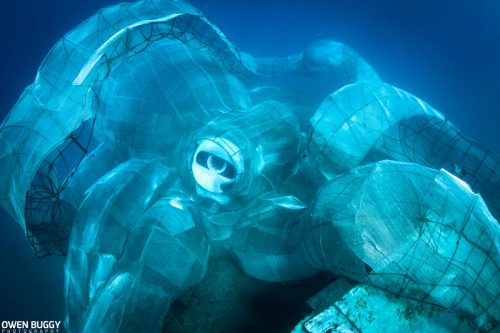Start with an old barge.
Get some artists to build a steel frame superstructure in the shape of a kraken on top of it.
Then tow it out to sea and sink it to create an artificial reef.
That part’s done, now wait a few centuries for it to be populated with crusty layers of organic material.
It’s going to be beautiful. It already is!



! That’s fabulous. So fabulous.
If you really want to confuse future archaeologists, outfit a restored Viking longboat with a 1950s outboard motor, load it up with artefacts from across the ages and around the world, and sink it off the coast of New Zealand.
Callinetes @2: And be sure to include a bunch of issues of Thor comics.
For realsies though that would really fuck with attempts to reconstruct a taxonomy from fossil records. x)
I think this may be the most wonderful thing I’ve seen in a long time.
So they DID release the Kraken!
At least Sir Richard is having fun. That so, as a true ignoramus in these matters, I wonder if the ship might well be covered in “crusty layers of organic material” much sooner than a “few centuries”? Where is a marine biologist when you need one, amirite?
I would be more impressed if I hadn’t noticed the huge plume of leaked fuel on the surface at the very end of the video. Aren’t they supposed to clean the ships before they sink them? Looks like they sunk it in a tropical country without proper environmental regulations.
Someone needs to bury some petrified rabbit bones down in the burgess shale. No, wait, no – don’t.
We’re not that easy to fool.
Given that future archaeologists might be cephalopods, I imagine they would be very intrigued.
I remember reading some time ago about some experiments with “growing” calcium on some kind of armature in sea water using some small electrical current do not know any of the details but the idea combined with this one is intriguing.
uncle frogy
@quatguy
According to the video it was sunk at Virgin Gorda, British Virgin Islands. Decades of hydrocarbon residue can be pretty difficult to completely erase without extensive cleaning with degreasers and abrasives, but no excuse if it was caused by any amount of liquid or sludge that can scraped out.
@unclefroggy
It is usually called bio-rock. Research started back in the 1970s simply for creating concrete structures from salt water, but still not too many people use it with reefs despite the fact that it is a super easy and inexpensive method to encourage faster and healthier reef growth. All you need is a bit of electrical assistance via (floating) photovoltaic panels tethered to the metal skeleton/armature. Since the accretion is mostly calcium carbonate, it turns the process of artificial reef construction into a decent means of carbon sequestration compared to crap cast concrete reef starters (unless using waste carbon dioxide to aid the curing process and reduce the amount of required portland cement). The electrical assistance possibly also helps limit/prevent coral bleaching, but not sure that result is super well supported.
Well, they’ll figure that one out right after they discover the deep cultural meaning of the cigarette stubs my father in law buried in all kinds of we concrete, mortar, plaster etc. around the house.
Giliell
burrying things?
it was the squirrels
… a steel frame superstructure in the shape of a kraken …
Translucent steel?
I’ve been waiting for this ever since reading of “glassteel” in the “Tom Corbett, Space Cadet” stories!
But… it looks like it landed on its side! I was waiting for the final underwater shots to show that they had re-righted it before it hit bottom, but they never came! Is there now a beautiful Octo-Exo-Skeleton sitting half-crushed by a barge?
Cuttlefish, I’m pretty sure that photo under the video is of it underwater.
True… but with no bubble trails to tell us which way is up, it could be at any orientation. I want to believe it is right-side-up, but the video really makes me wonder.
Further googling leads me to have hope. It does look upright.